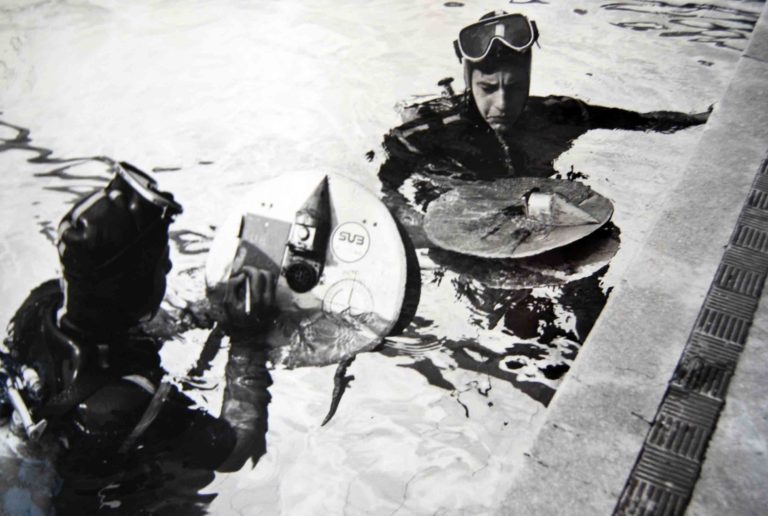DAN Europe founder Alessandro Marroni is realising a 50-year-old dream, says MICHAEL MENDUNO, chief of InDEPTH magazine (of which news below). As the title published this interview late last year, Dr Marroni and his team were preparing to test their real-time diver-monitoring system DANA-Health. It’s an integrated sensing device, app and intelligent cloud service that promises to usher in a new era of diving safety and reveal what’s long been hidden – what happens within our bodies during a dive. What could DANA-Health mean for your own diving? Photos courtesy of Dr Marroni and DAN Europe, for which (full disclosure) Menduno is also a senior editor
As this issue of InDEPTH went to press, Dr Alessandro Marroni and a team of researchers from DAN Europe were preparing to test a beta version of their DANA-Health Sports Monitoring & Advanced Telemedicine system in the Deep Dive Dubai pool complex.
The real-time diver monitoring system – the brainchild of the pioneering 75-year-old diving and hyperbaric doctor and scientist – has been 50 years in the making, ever since Marroni set out the concept in his 1971 graduate thesis, and it promises not only to provide a new level of diving safety, but to open up new avenues for diving research.
As envisioned, DANA-Health could be deployed to monitor expedition divers and provide guidance if needed on their decompression should they run into problems. Alternatively, it might be used to assess and recommend treatment for an injured diver on a holiday liveaboard, or serve as an aid to deliver telemedicine services to non-divers engaged in activities such as remote wilderness skiing or trekking.
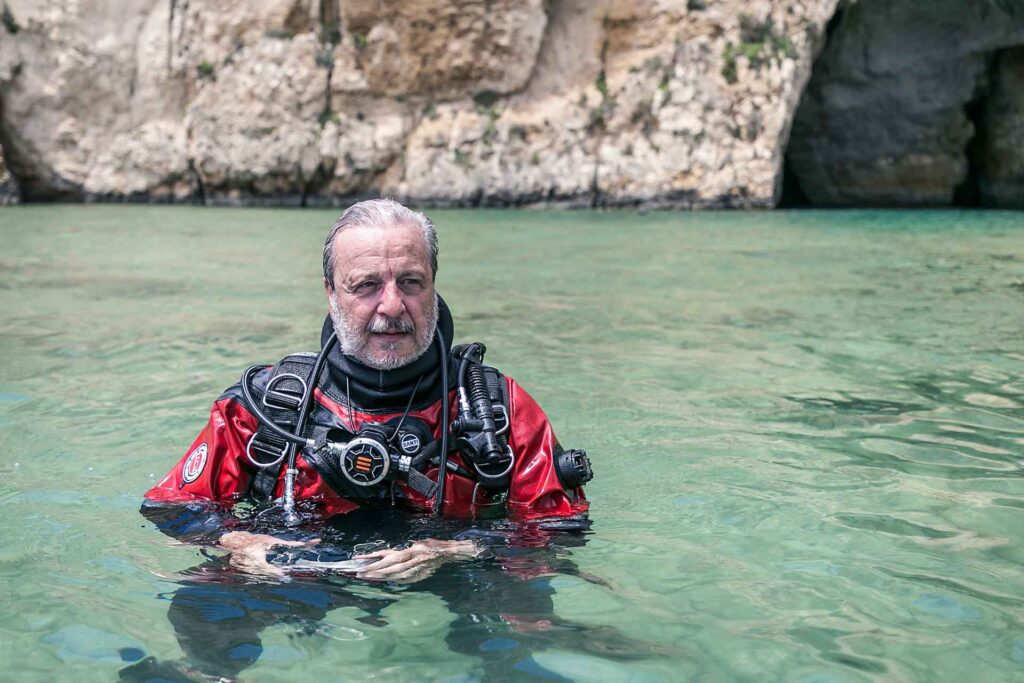
Highly respected throughout the diving, medical and scientific communities, Dr Marroni has devoted his career in diving and hyperbaric medicine, including publishing more than 250 peer-reviewed scientific papers, to the problems of measuring and collecting diving data, analysis and interpretation – and ultimately to the prevention of diving accidents through better knowledge of their possible root causes.
He is perhaps best known by the diving public, of course, for this latter role, as the founder of the
organisation that eventually became Divers Alert Network (DAN) Europe, in parallel with Dr Peter Bennett’s DAN US, in 1983.
The DANA-Health system embodies these three themes of Dr Marroni’s career. The system is able to measure a growing number of a diver’s biometrics, including heart and breath rate, body temperature, decompression stress, blood chemistry and other metrics in real time while the diver is under water.
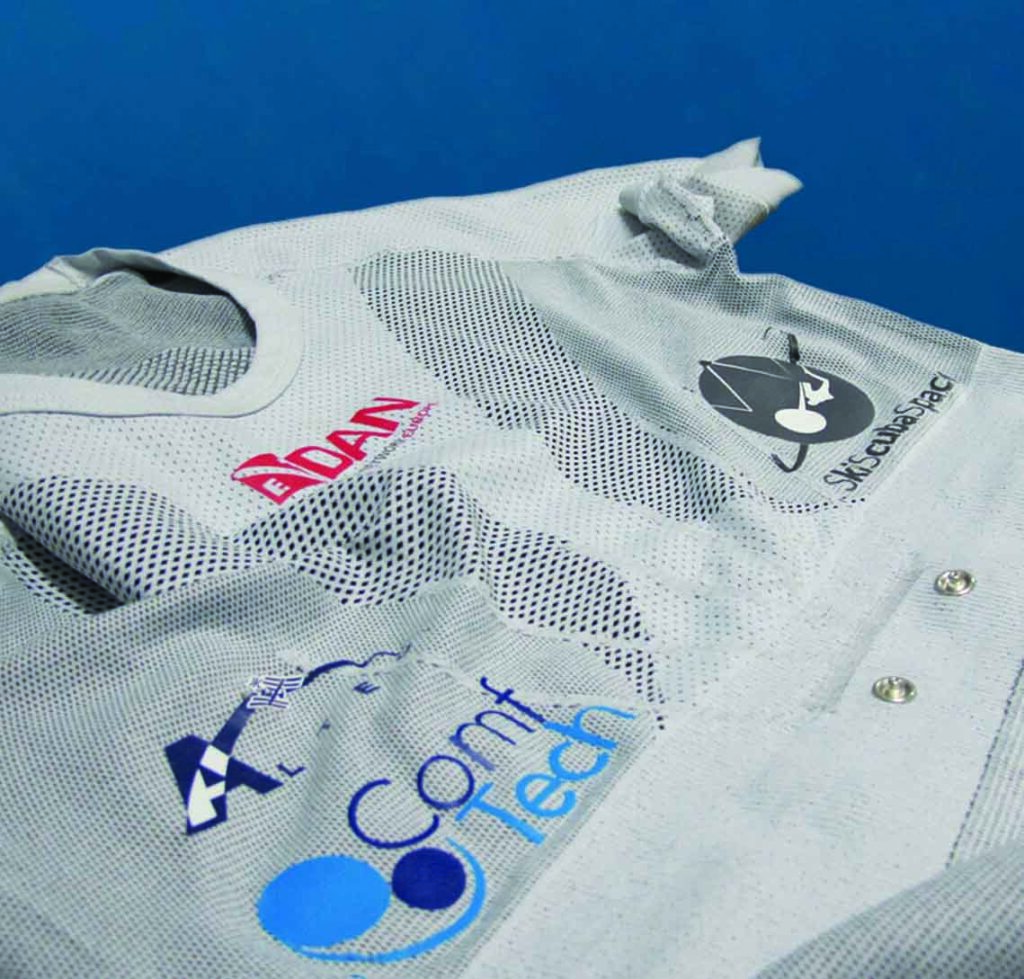
The system can transmit the data to the surface, where it can be monitored and/or sent to an automated cloud data centre for processing and analysis and be integrated with an emergency management system such as the DAN 24/7 hotline and diving doctor network, and/or an intelligent mission control. More on this later.
While DAN researchers and their partners continue to test and further develop the system, their next step is to productise the DANA-Health system so that it can be made available to the diving public. We reached out to Dr Marroni as he was preparing to leave for Dubai, and asked him to explain his
vision and the making of DANA-Health. Here is what he had to say:
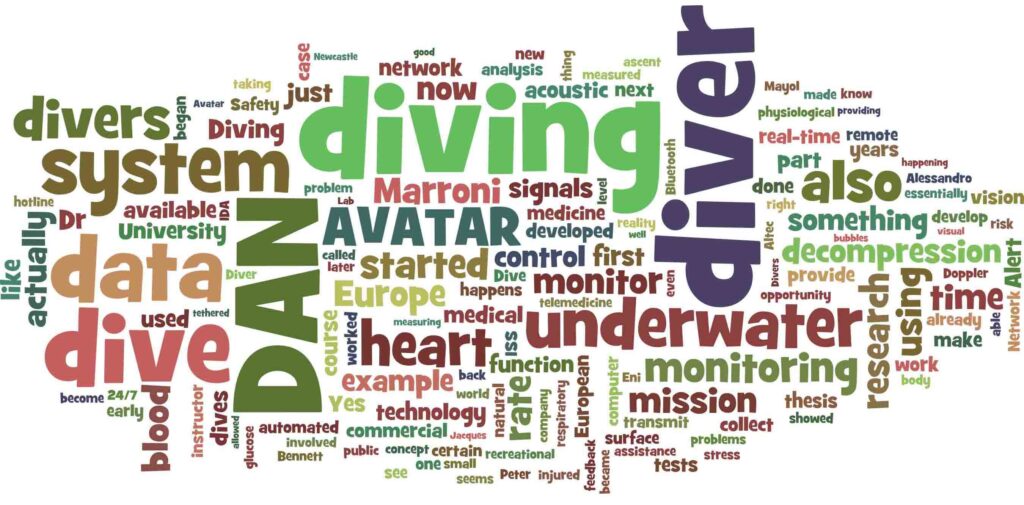
InDEPTH: I watched one of your talks on Zoom and saw the plaque on your desk with a quote from Walt Disney: “If you can dream it, you can do it.” Those words seem to encapsulate the story of DANA-Health just perfectly.
Alessandro Marroni: Well, that is simply my life philosophy, to just follow your visions and firmly believe that a winner is just a dreamer who never surrendered. [Marroni smiles]
Obviously you have never surrendered! I was amazed to learn that you first dreamed of what is now DANA-Health 50 years ago while you were a medical student, and published your graduate thesis, Exploring Cardio-Cerebral Monitoring in the Underwater Swimmer, in 1971. What inspired you to choose that as your thesis topic?
Well, I was already a diver and a diving instructor – I learned to dive at age 13 and became an instructor at 19. I worked as an active instructor during my medical studies and was looking for a thesis topic.
At that time I was a resident in clinical medicine at the University of Bologna, and my mentor Prof Giulio Sotgiu, who is listed on the thesis as my mentoring tutor, was a cardiologist and very involved in monitoring sports activities. I told him that I wanted to go into diving medicine; I had known since the beginning of my studies that was what I wanted to do.
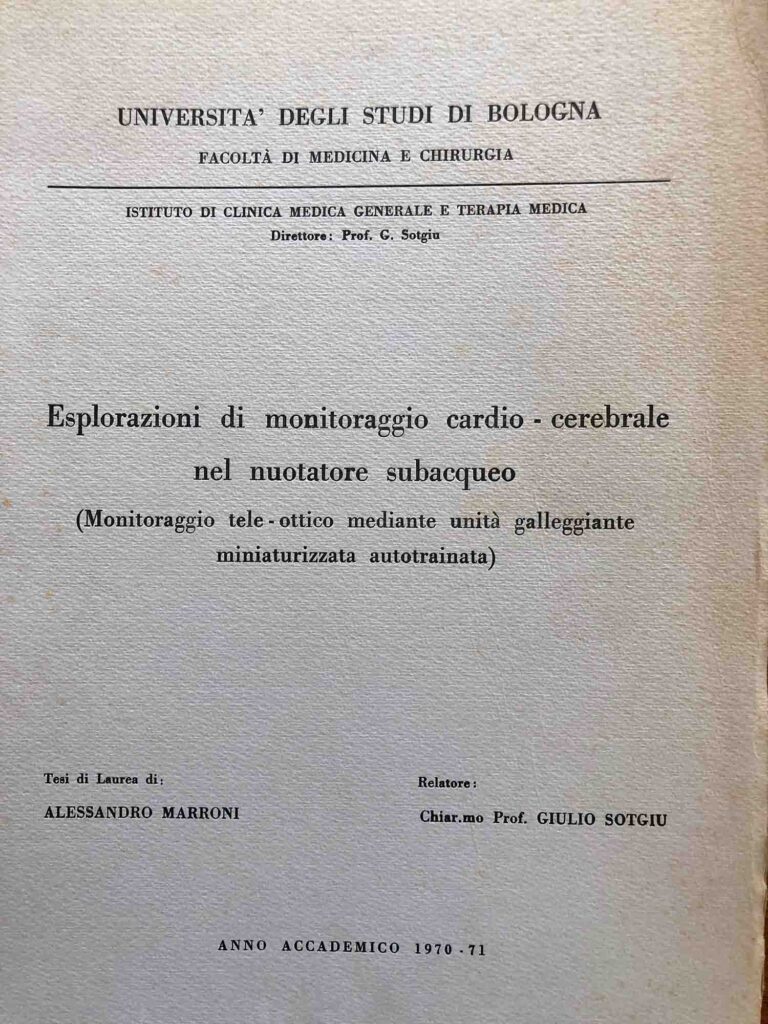
Professor Sotgiu had developed a system to monitor heart frequency using light transmission through the soft tissues, and he suggested that we apply this to divers. At that time there was no wireless through-water transmission, so the diver was tethered to the surface. From there we could actually see the subject’s heartbeat and heart rate frequency, which was transmitted with light signals. It was just natural and seemed like an obvious thing to do.
Since that time, you have spent years monitoring and taking physiological measurements of divers, not just before and after dives but while they were actually under water. You have recorded heart functions, taken bubble readings, measured hydration, drawn blood and measured blood chemistry. Why is it important to monitor divers during the dive, as opposed to just before and after?
What happens in a diver before and after a dive has been extensively studied; however, that’s not the case when they are under water. Further, our field research has shown that some variables, like the production of nitric oxide (NO) for instance, may seem not to change before and after the dive, but when we took blood samples during the dive, we could observe very significant changes.
This is just one example that however bears some implications, since this substance is related to the function of the endothelium, and this is related to the response to and formation of gas bubbles. Further research has shown that such changes of the endothelial function, or specifically irritation of it, can also be identified by monitoring heart function.
Are you referring to recent work on heart-rate variability?
Yes. There is a study that we are doing with the University of São Paulo in Brazil about heart-rate variability. The scholar and researcher we are co-operating with is Sergio Schirato, who is a specialist in cardiology as well as a diver.
Yes, Dr Schirato wrote a story for us in 2020 titled: Heart Rate Variability: What it is and Why it Matters.

He is part of our multinational team, and he has developed a modality to interpret the endothelial stress from certain variables in heart rate. It so happens that the estimation of the endothelial stress matches with our estimation of decompression stress in post-dive bubbles. Which means that we could have an early marker for decompression illness (DCI) if we want to verify heart function under water.
Fascinating!
Another example is exercise. It was always believed, and has been retrospectively assessed, that parameters such as exercise have an influence on human response to decompression, and the level of exercise can be monitored through respiratory and heart rates. The same applies to certain environmental parameters, such as temperature.
So the ability to monitor divers in real time while they are diving can provide key insights into what’s happening, and that data can be analysed using tools like DSG, the Diver Safety Guardian – our decompression risk analysis model, for example – and the results can be used to, say, modify their decompression plan. The software is contained in our watertight Dive Sense device.
So a diving supervisor could monitor their expedition divers, for example, and advise the divers and make changes to their deco plan, depending on their physiological status.
Exactly. We could compute what would be the best ascent for the diver taking into account, for example, their heart and respiratory variables.
Wow, that’s exciting! You mentioned your start monitoring the cardiac functions of a tethered diver for your thesis. I read that you also worked with freediving pioneer Jacques Mayol back in the ’70s, taking subsurface measurements on his record dive to 86m.
Yes, I was measuring his heart rate and also his mental performance with some visual and manual co-ordination tests. I used a small pegboard, where you have to insert the peg into the proper hole. It’s something childlike but very effective. I took measurements during his training period.
On the record dive, he allowed me the time to measure his heart rate. But on the other training days, he made dives close to 86m deep; we were diving every day between 75 and 80m. He gave me time to do all these tests – both the mental and the psychomotor co-ordination tests, and heart rate.
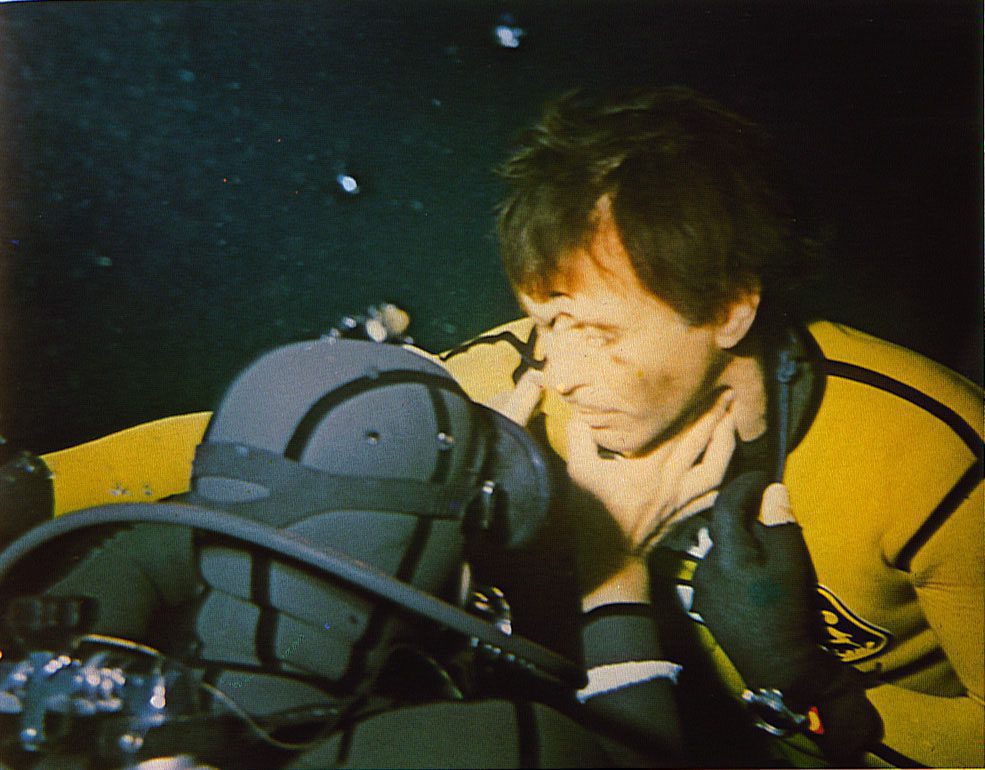
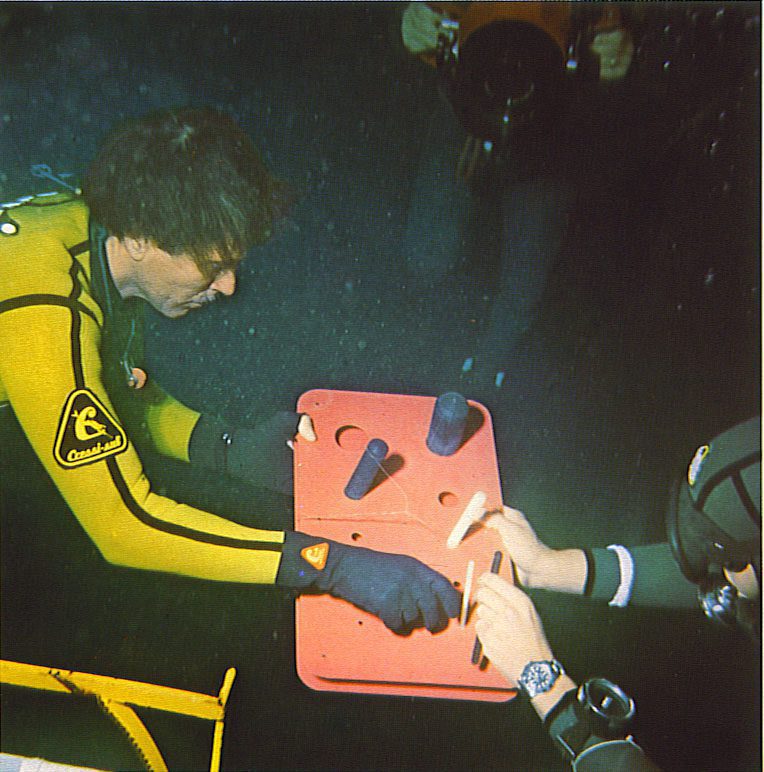
At that time, the instruments available were not as sophisticated as they are now. In fact, that’s where I began the move towards digital medicine – I actually measured his heartbeat with my digits. (Dr Marroni holds up his fingers and laughs!)
Digital medicine, right? Ha! It seems obvious that we’d want to monitor divers’ physiology during the dive. The problem is that it has been difficult to accomplish that under water.
That’s right. If there’s no water, everything is simple. That’s why I wanted to develop the system for use under water, even in space. If you can do something under water, you can do it everywhere. Of course, with Jacques Mayol, conducting manual tests was the only thing I could do. But things continued to evolve. We were hungry for data, and we began developing new systems and approaches.
We put a Doppler probe in an underwater case so that we could actually monitor bubbles at the bottom and during the ascent. We put echocardiographs in a pressure-resistant case so that we could actually do underwater echocardiography.
Eventually, we started drawing blood under water. So, the next step was obviously to develop modalities to monitor any other physiological function under water. This is where the DANA-Health concept started taking off.
Clearly the development of biometric technology and availability of wearable sensors has helped a lot. We started working with existing technology and adapting it to the underwater world. But we had a problem. The problem was that having a tethered sport diver was not so easy or comfortable. So we had to overcome this issue.
How did you do that?
We had the great opportunity to partner up with Newcastle University in the UK. We had been introduced to them through an important project that we got involved in called Cognitive Autonomous Diving Buddy (CADDY).
Basically, we developed an underwater robot or ROV that could monitor and interpret the hand signals and body language of a diver together with other physiological parameters. Newcastle had developed a very smart underwater signal transmitter using ultrasound and acoustic modems as part of the project, and we co-operated with them.
We were conducting a diabetes monitoring study – we were actually monitoring blood glucose in diabetics under water. A display would show both the diabetic diver as well as the instructor the diver’s blood glucose level. The idea was that real-time monitoring would enable a diabetic diver to know what was happening to his or her blood glucose during the dive, so that they could take appropriate action.
The result was a very nice paper with a protocol that would allow diabetic divers to dive more safely, and also included this real-time monitoring of the blood glucose level during the dive, not only before.
Initially, we were using Bluetooth to do this. But under water Bluetooth doesn’t go more than 20 to 30cm, and so the poor diver had to place the monitor very close to the subdermal transmitter to see the display. That was obviously not so practical. But Newcastle showed us how to transmit signals using ultrasound and acoustic transducers. The effective range was up to 3km if you have a line of sight, which is very easy under water.
That was the breakthrough! It enabled us to capture the signals from wearable sensors on the diver and transmit them to the surface with an acoustic transducer, essentially an acoustic modem.
From there, of course, with a good antenna and GSM (cellular) or satellite connection, you can transmit the data anywhere in the world. So that moved our project forward, and my youthful vision and dream started to become a reality.
It’s another key component of the DANA-Health system.
We also had a great opportunity to meet with Comftech, a company based in Milan that developed a very novel technology, a textile technology that actually collects data, and can then transmit it through a small Bluetooth transmitter. The Bluetooth signal is sent to the acoustic modem that is worn by the diver on the wrist like a dive computer, and then the acoustic modem transmits it to the surface.
That opened up a whole new world. These intelligent textiles can collect electrocardiogram, temperature, respiratory rate, geolocation and body position data by using an accelerometer – whether it’s heads up or down, or horizontal, or falling.
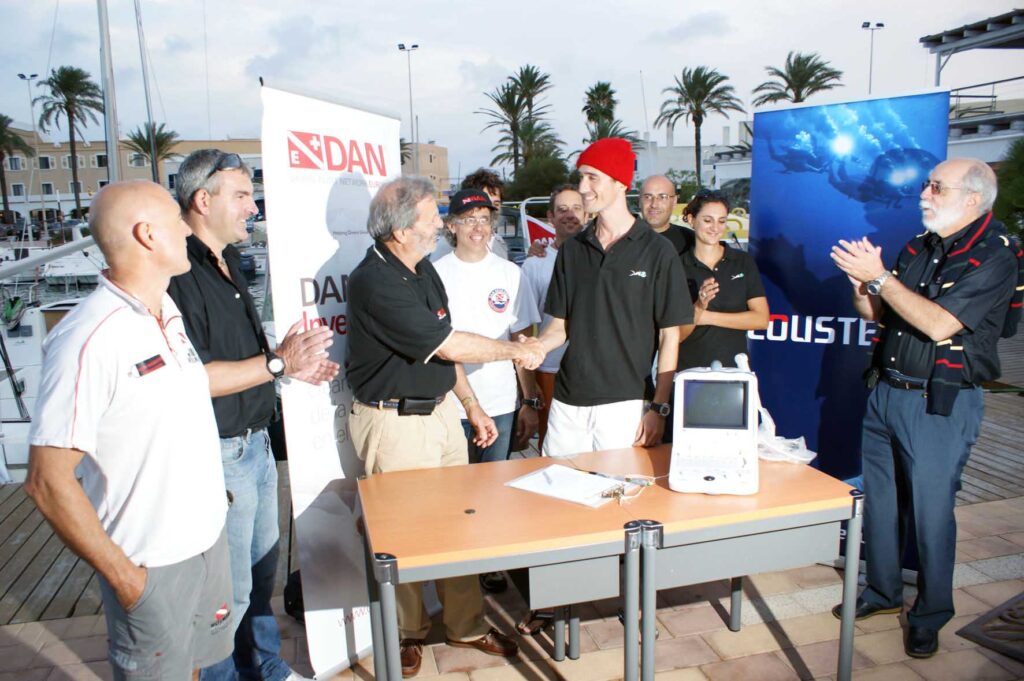
That was part of the DAN demo that you showed me. A diver surfaces from a repetitive afternoon dive on a liveaboard in the Maldives and he is not feeling good. So he puts on the DAN monitoring shirt, connects to his phone app and calls DAN. He is then connected to a diving physician who can read his biometrics as well as the dive profile from his computer, and can diagnose him and recommend treatment. Amazing!
It was a natural evolution for us to begin to collect diving data in addition to the accident data that we were already collecting. This is something that I started with Dick Vann and Petar Denoble, who were then at Duke University and DAN US back in the early 1990s.
We worked with many computer manufacturers to essentially include a “Send Data To DAN” button on their devices to put together what is now the data-collection system that DAN has and shares. On the European side, we have the Diving Safety Lab, which as you know, has become part of the DANA-Health system. DAN US had the Project Dive Exploration data.
In addition to the dive profiles, we collected information about the diver through a questionnaire, which is conducted after the dive. The questionnaire includes information on their habits and what happened to the diver before the dive – whether they were rested or unrested, had slept, had drinks, smoked and so on. That allowed us to collect a large amount of data for epidemiological research.
We also started running field research camps in 1993 where divers could participate in organised field research. We invited DAN members to participate, and we continued to collect data.
During my early days working as a commercial diving doctor, I acquired Doppler recording units shortly after I worked with Mayol. I routinely used these Doppler probes with my commercial divers, and it was natural to start using them on recreational divers. They were the very first tool that we used during these camps – what we called the Diving Safety Lab research camps – and we continued to collect data before and after the dives.
Eventually, we focused on three assessments. One was the Doppler assessment, post-dive, with a certain protocol. The second one was hydration – we measured hydration through urine density before and after the dive. In addition, on many occasions, we also measured blood density with a small pinprick amount of blood that we processed for haematocrit and haemoglobin.
That allowed us to analyse a serious amount of data. We published the first results in 2000 and published our last study about diving risk factors about four years ago, based on 40,000 dives. (See Identifying Decompression Risk Factors, Alert Diver.eu).
I know that you used the Dive Safety Lab database to develop your decompression risk analysis model among other things. Let’s talk about the third component of the DANA-Health system, mission control, and the DAN emergency management system.
Your first job out of medical school was as the diving medical officer (DMO) for the Italian national oil company, Eni SpA (Ente Nazionale Idrocarburi). And that, in fact, led you to create what eventually became DAN Europe.
That’s right. I first worked with Eni while I was resident at the Institute of Occupational Medicine at the University of Genoa from 1972-74, and then I became the medical director for their underwater work when I left the university. I was involved in all of their commercial diving activities for more than 10 years until 1985. In fact, I shared one of my experiences from that period in Stratis Kas’ book Close Calls.
I remember that story!
Eni was conducting compressed air dives to 50m, but also starting to work with artificial breathing mixtures for deep bounce diving, as well as saturation diving. We did some of the first deep bounce diving with heliox, using a diving bell and umbilical, and also the first saturation dives.
Now, in the late ’70s and early ’80s, European diving was booming with the advent of dive travel, and dive destinations like Sharm El Sheikh and the Maldives were busy. Predictably, incidents of DCI were also on the rise. I was already an active PADI instructor, having done my crossover from CMAS with Steve Metcalf.
At the time the idea of providing the recreational diving community with the same type of assistance we were providing to commercial diving teams worldwide was just a natural development of my work. I was doing telemedicine, we had 24/7 phone assistance, dispatching teams and arranging air evacuations and so on.
So in 1980 I started envisioning the programme, which then began in 1982 as International Diving Assistance, or IDA, with an international 24/7 hotline to provide guidance to injured divers regarding treatment in the few chambers that were available in those early years.
I was later helped by my wife Nuccia and a small network of like-minded diving physicians to further develop IDA, and to add a diving insurance programme.
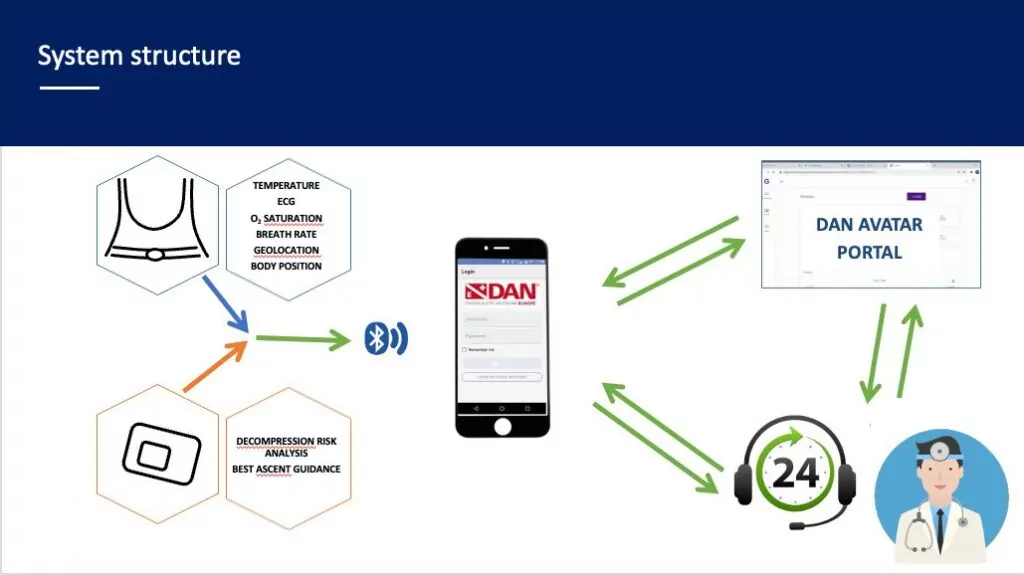
I was already a member of a number of scientific societies. I had served as the president for European Underwater & Baromedical Society (EUBS), vice-president of the Undersea Hyperbaric Medical Society (UHMS), and we had started the European Committee for Hyperbaric Medicine (ECHM). So it was natural for me to ask my friends and colleagues: “Why don’t we build a European network?” And that is how we built the multilingual, multinational DAN Europe network.
That was the beginning of what would become the Divers Alert Network. Of course, in parallel, Dr Peter Bennett from Duke University had set up a diver hotline in 1980 in the States called the National Diving Accident Network divers’ hotline (NDAN) with grants from NOAA (National Oceanic & Atmospheric Administration) and NIOSH (the National Institute for Occupational Safety & Health) to address the needs of recreational diving.
Yes, I met with Peter, who was also involved in saturation diving research at a conference in Aberdeen, Scotland, in the late ’70s. I knew what he was doing, and he knew I had similar aims.
Later in 1986, you and Bennett decided to collaborate and form two independent Diver Alert Network organisations: DAN Europe and DAN US.
I had started operations as IDA, then agreed with Peter to also adopt the name DAN followed by “Europe.” Around that time, it began to dawn on me that I was interested in pursuing research and teaching, and I left Eni a few years later, and began teaching at University of Chieti in Abruzzo, where I live now, and of course concentrating on my work with DAN.
As we talked about in the example of a liveaboard diver getting bent, the DANA-Health system can easily be integrated in DAN’s emergency network for treating incidents. But you have another larger vision. You see DANA-Health being integrated with an automated, cloud-based mission control function.
Yes, that came out of our work with a company called Altec, which is part of Thales Alenia Space, which works with the European Space Agency (ESA). Altec is the company that actually built the International Space Station (ISS) modules, and they maintain a mission control for the technical aspects of the ISS in Torino; they are connected to the ISS all the time.
Altec sponsored and helped us greatly with the DANA-Health concept and developing an intelligent mission control function that would collect the data coming in from divers, analyse and interpret that data and, if warranted, report the situation to a human mission control that could reach out to the diver, and so on. This led us to the concept of “bidirectional telemedicine”.
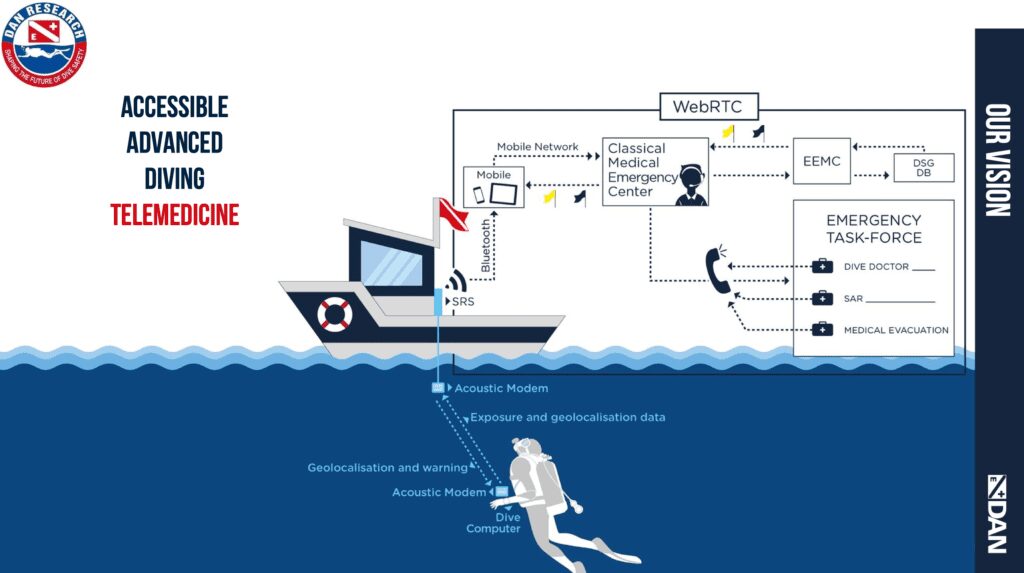
Telemedicine is usually done over the phone but, of course, it can now be done with videoconferences. You can look at the patient and provide [virtual] assistance using the physiological or pathological data, including visual data, that comes through the system to a mission control, which is made up of two parts.
The first is an automated mission control, very much like you would have in an intensive care unit, that displays heart signals, lung signals, breath rate and so on. If certain thresholds are reached, either high or low, an alarm would fire.
So in the case of a diver this could apply, for example, to someone diving with heart problems or something like that. If the alarm fires, then the human alarm centre is alerted, and a search and rescue operation could be started, or at least the diver could be notified that there is a problem.
The second part of the system was providing feedback to the diver. Using the GSM network and acoustic modems, we realised that we could send back signals to the diver under water.
We developed a modality to actually send text messages, which require minimum bandwidth. So, we started using coded messages that would mean: How are you? Are you OK? You’re not OK. Remember I showed this to you in the simulation of a diving accident.
Yes, I remember that demonstration.
This is bidirectional telemedicine, because we now have the opportunity to actually send some feedback to the remote diver or patient. Of course, in the case of an injured diver at the surface, a physician could speak with them directly through an app.
It could also be used to communicate with a bystander who was helping the diver and could benefit from the knowledge and experience of a remote specialist – they would essentially become an onsite avatar of the remote specialist. In the case of the ISS, for example, Altec has systems that can guide an astronaut, via video and augmented reality, to fix an electrical panel on the ISS.
Wow! The future’s so bright, I gotta wear an Oculus Rift!
Our challenge now is to develop some sort of visual guidance, which would use augmented and virtual reality to show a bystander how to help the injured diver. That is the next step. We are not there yet. We are pretty happy where we are at the moment, and with being able to communicate with our diver with coded signals.
The good thing is that, as I showed you, the system now allows us to monitor the dive during the descent and ascent, with automatic feedback, say every 5m, that displays data about heart and respiratory rate, and also decompression-related data.
With that, our Diver Safety Guardian system is able to do real-time decompression risk analysis, and also to understand what would be the best ascent given the diver’s descent and bottom time.
A brave new world. So what’s next? What are the next steps going forward?
The next steps are to make DANA-Health available to the public. Obviously, we will need to industrialise it, and we will need to make it available at affordable costs. It shouldn’t be something that only Elon Musk can afford, but something more basic, like a normal Chevy or Ford.
We also aim to integrate DANA-Health with current dive computers, because it’s not a dive computer. Rather, it will take data from the environment, from the diver, from the dive computer, and then integrate them into a meaningful stream of data. It would be the diver’s advisor, his or her guardian angel.
The system would enable the diver to be in contact with a remote expert, which could be an automated expert, because we are working with artificial intelligence. If the diver chooses, they can be in constant contact with an automated mission control, sending data to a central database that would be able to provide feedback if something goes wrong – to fire an alert signal, for example. It’s not a far-fetched goal, because this is already in the prototypes that we are using.

Do you plan to team up with commercial enterprises to help productise the technology?
Most probably yes. DAN is a foundation that provides service and insurance. It is not a manufacturer. So we will likely partner up with companies that can help us. I see it more as an intellectual property and opportunity that we offer to the diving community. If there are manufacturers that are ready to come on board and also share the benefits, so much the better.
On the other hand, one thing we are very proud of is the portal that serves as the repository of divers’ data, a kind of clinical record of the dives. That is something that, for sure, DAN will retain because that is part of our assistance mission. The monitoring tools, the integration of existing sensors into the system and so on, are all simply a smart use of the existing technology.
In a recent talk you said DANA-Health will make a difference. It will make it possible for DAN to be ever more of a dive-buddy.
Yes. Not if, and not even when. This is now a reality and only needs to be industrialised to be made available. DAN will end up being a dive-buddy, not only before and after your dive, but even when you are diving.
It seems to me that DANA-Health represents a major paradigm shift, enabling us to pull back the veil and see what’s happening to a diver throughout the whole dive. That’s something that has only been done in pieces before. It seems very powerful.
DANA-Health will be extremely important for research because it unveils what has been veiled so far – and that is what happens during the dive.
What happens before and after has been extensively studied by many. What happens during the dive has been barely studied, in certain very advanced military environments, but is not done anywhere else. Definitely not in commercial diving environments, even less in recreational diving environments.
We are essentially applying technologies that are common in space medicine today – astronauts are monitored this way. We want to make this kind of technology, and real-time monitoring, which can be very useful in terms of knowing how your body is responding, and alerting the diver to potential problems, available for the diving public.
It’s a powerful vision, Dr Marroni. Let us know how your tests go at Deep Dive Dubai. And please keep on dreaming!
- Since this story was first published in December 2021, DAN Europe has changed the name of its diver monitoring system from AVATAR (Advanced Virtually Assisted Telemedicine in Adverse Remoteness) to DANA-Health, Sports Monitoring & Advanced Telemedicine. We have replaced the name in the original story with DANA-Health.
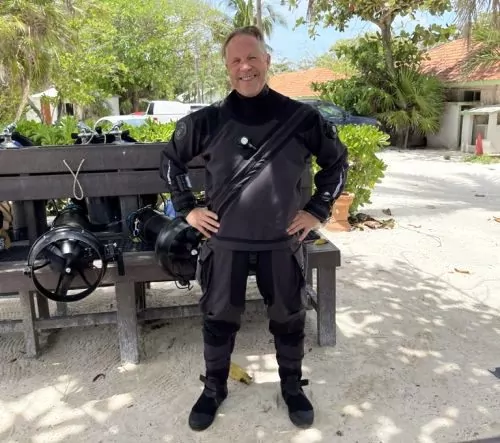
M2’s InDEPTH bids
for world domination!
Michael Menduno, aka M2, is editor-in-chief of InDEPTH, which he describes as the only magazine today dedicated to technical and mission-oriented diving. An award-winning journalist and technologist, Menduno has written about diving and diving technology for more than 30 years – and it was he who coined the term “technical diving”.
His magazine aquaCORPS: The Journal for Technical Diving (1990-1996) helped usher tech diving into mainstream sports diving, and he produced the first tek.Conferences and Rebreather Forums 1.0 & 2.0. Also an editor/reporter for DAN Europe’s Alert Diver magazine, he is on the board of the Historical Diving Society (USA) and a member of the Rebreather Training Council.
Now in its fourth year, InDEPTH has just doubled its staff by bringing in four new faces in its efforts to deepen and extend its coverage and content of the underwater world. “Hosted by the impassioned divers at Global Underwater Explorers (GUE) as an offering to the global tech community, the goal of the spirited publication is simple: benevolent world domination!” says Menduno. “We want to be the #1 must-read, global publication for tech, cave, breath-hold and other mission-oriented divers.”
Each issue, a “labour of love and/or narcosis”, takes a deep dive into topics such as exploration, diving safety and human factors, diving physiology, technology and equipment, training, community, conservation, art and culture and diving history.
InDEPTH posts on the first Thursday of every month and subscriptions are free. Subscribers also receive a weekly email with new stories and content, written by leading explorers, scientists, engineers, educators, hyperbaric docs, conservationists and divers. “We want to be the go-to source for the people who can’t get enough of this stuff – the water tribe people,” says Menduno. “I like to think of it as aquaCORPS for the 21st century.”
Check it out here, and also download InDEPTH’s excellent and free ANNOTATED TEKKIE poster.
